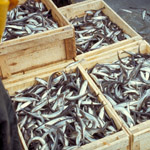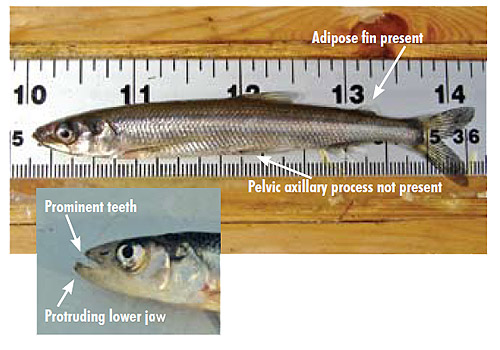Rainbow Smelt
 Osmerus mordax
Osmerus mordax
Other common names: Smelt, American Smelt, Freshwater Smelt, Leefish.
Description
Body: elongate, compressed sideways, deepest from front of body to dorsal fin origin; total length 178-203 mm (up to 350 mm).
Mouth:Â Large, without barbels, with prominent teeth on the tongue and the roof of mouth; lower jaw protruding.
Fins: without spines; single dorsal fin with 8-11 soft rays; caudal fin forked; anal fin with low profile and long base, 12-16 soft rays; adipose fin present.
Scales: thin and easily detached, 62-72 pored scales in an incomplete lateral line.
Colour: black to olive-tan back, silvery sides with iridescent blue, purple and pink hues, and whitish belly; head and posterior edge of tail darkly pigmented.
Similar Species: Superficially similar Minnow species lack an adipose fin and prominent teeth. In salmonids, including trout, salmon, lake herring and whitefish, the lateral line is complete and a pelvic axillary process is present
Habitat
Clear lakes, rivers and coastal waters, often schooling in open water and spawning in streams.
Impacts
Native fish species are impacted through competition with, and/or predation by Rainbow Smelt. Affected species include Yellow Perch (Perca flavescens), Walleye (Sander vitreus), Lake Herring (Coregonus artedi), Bloater (C. hoyi), Whitefish (C. clupeaformis), Lake Trout (Salvelinus namaycush), and Slimy Sculpin (Cottus cognatus). Invasive Rainbow Smelt may disrupt food webs and induce significant changes in zoo plankton communities.

Photos: Main - Mark Gautreau, Canadian Rivers Institute,University of New Brunswick; Inset - Robert Eakins, EcoMetrix Incorporated.
For more information visit Ontario's Invading Species Awareness Program.
Â
Back to Aquatic Invasive Species List
Â

